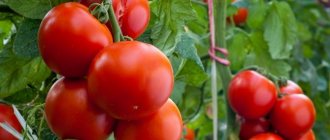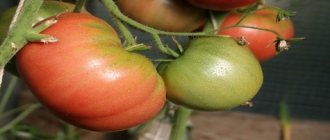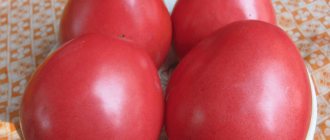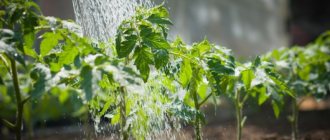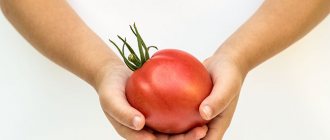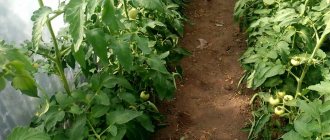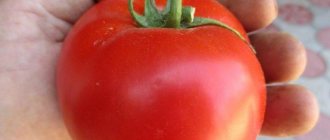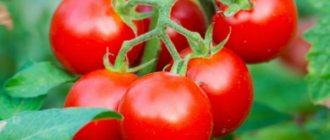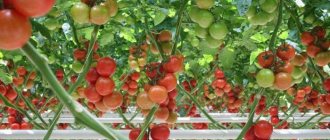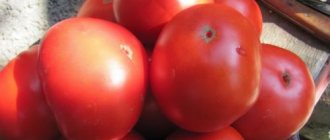Characteristics and description of the tomato variety Lyubov
The tomato variety Lyubov F1 can hardly be called new on the market. For more than 10 years, summer residents have been growing it in open ground with great success. Sellers of seeds and seedlings are happy to recommend this hybrid to their customers. It is worth paying attention to if you choose early or mid-early varieties.
The tomato variety Lyubov F1 is well-deservedly popular among owners of large greenhouses and farmers due to the beautiful appearance of the fruit. This determinate, medium-sized standard plant, 120 cm high, has the following features:
- early ripeness;
- ripening period – up to 105 days;
- fruits are round, dark crimson;
- high yield, the ability to harvest up to 6 kg per bush.
Important!
The tomato variety Lyubov F1 is resistant to most diseases and is undemanding to growing conditions. Video characteristics of the tomato variety Lyubov F1:
Formation of determinate tomatoes on video
If you grew Lyubov f1 tomatoes, please write whether you liked them or not. Will you grow them again? How do you assess the disease resistance of this hybrid? Briefly describe the advantages and disadvantages of this tomato. If possible, attach to your review a photo of the entire bush as a whole or individual fruits you grew. Thank you!
Your reviews of the Love tomato and additions to the description will help many gardeners evaluate this hybrid more objectively and decide whether it is worth planting or not.
Taste qualities of tomatoes Lyubov F1
This is a real giant, especially if you take into account the early varieties of tomatoes. Weighty fruits are formed on the branches, each weighing 250 g, and individual specimens reach 400 g.
Characteristics of tomatoes:
- their shape is smooth and round.
- When ripe, the fruits are painted a bright, reddish-crimson color;
- there is no green spot in the stalk area;
- durable tomato skin protects against cracking and facilitates transportation;
- the taste of ripe fruit is pronounced, with slight sourness;
- up to 96% of the crop has no errors in appearance.
You can use Love F1 tomatoes:
- for decorating sandwiches;
- preparing salads;
- seasoning summer soups and main courses;
- in preparations such as ketchup or paste.
Advice! Large Lyubov F1 tomatoes are not used in winter pickling, but are great for making juice or pouring for other vegetables.
New hybrid My love
If you are interested in new hybrids, it would not hurt to read the description of another early hybrid - the My Love tomato. These are earlier tomatoes than the Lyubov F1 tomatoes described above. The ripening period is between 80 and 90 days. Fruits with cute noses have a regular round shape and are red in color when fully ripe.
The description of the pulp is impressive: sweet, juicy, sugary. The fruit size is average (150 - 200 g), so they can be used for canning and pickling, but the best use is in salads and juices. At the beginning of summer, it is useful to eat a ripe, red tomato from your garden.
The bushes of the My Love tomatoes are low-growing (65 - 80 cm), easy to care for, as they do not need shaping and stop growing on their own after five clusters on the central shoot.
Due to their small growth, they do not need to be tied to supports, but perhaps if there are a large number of fruits, a support will still have to be installed, otherwise the bush may collapse from the weight of the tomatoes. Growing this hybrid requires a minimum of time.
See also
Characteristics and description of the Agata tomato variety, its yieldRead
Pros and cons of the tomato variety Lyubov F1
Each tomato has its own advantages, as well as disadvantages of varying severity.
The pros and cons of the Lyubov F1 tomato variety include:
| pros | Minuses |
| Resistant to drought and minimal moisture. | Powerful plants need abundant feeding, especially at the growth stage. |
| Easy adaptation to temperature changes and insufficient lighting. | Tying is done several times. |
| Fruiting begins long before the onset of frost. | An increase in the abundance of foliage, some of which has to be torn off. |
| Lack of moisture does not lead to shedding of color and ovary. | Requirement for fertilizing. |
| Good transportability, the dense skin of the fruit does not crack during transportation. | As with any hybrid, collecting seeds from the fruit is impossible. |
Important! Opinions regarding the sour taste of Lyubov F1 tomatoes are divided: some consider it a piquant feature of the variety.
Advantages and disadvantages
There are quite a lot of varieties and hybrids of tomatoes similar to the one under consideration; it is nothing outstanding, but, like any modern hybrid, it has many more advantages than disadvantages.
The fruits of the Love tomato are ordinary small red balls
The advantages of the Love tomato are:
- excellent presentation of the fruit;
- evenness of tomatoes, i.e. all tomatoes are approximately the same size;
- good transportability;
- no cracking under any conditions;
- good drought resistance;
- increased resistance to diseases;
- excellent taste, not always typical for tomatoes of this shape and size;
- versatility of application.
Among the disadvantages of the hybrid, they note the not very good yield, which strongly depends on the fertility of the soil, as well as the need for the formation and staking of bushes, which can be dispensed with for many determinate varieties.
Growing
Tomato Lyubov F1 is recommended to be planted on soils with slight acidity, which contain enough nitrogen, potassium, calcium and phosphorus. These indicators can be adjusted by adding lime (for low acidity) or sulfate granules (for alkaline indicators).
Tomatoes Lyubov F1 tolerate compost and rotted manure very well. These substances enrich the bushes with nutrients and have a positive effect on the soil composition.
Important! You cannot use fresh manure for feeding, as there is a risk of plant burns.
Tomatoes grow well next to zucchini, cucumbers, dill and carrots, parsley and cauliflower.
Growing seedlings
If spring in the region begins late, and the last frosts are not uncommon in early June, then Lyubov F1 tomatoes may be the only option to enjoy early tomatoes. The optimal time for sowing for this variety is late March or early April. Choose a wide, flat container with low sides. Lyubov F1 tomatoes are sown 60 days before the intended planting, but the timing is adjusted to the climatic characteristics of a particular region.
Important! If there is a greenhouse on the site, the sowing dates can be shifted.
Landing rules
The planting process is simple, but requires compliance with a number of important points:
- Seed selection. Good manufacturing companies perform this step themselves, but it would be a good idea to check the material again. To do this, place the seeds in salted water and remove those that float to the surface.
- Disinfection. To make Love F1 tomatoes less susceptible to various diseases, they should be kept for 20 minutes. in a weak solution of potassium permanganate.
- The next stage is soaking. The treated seeds are left in warm water for 12 hours.
- Hardening. Already hatched seeds are placed in the refrigerator overnight, and then kept for a day indoors at a temperature of + 20 ° C. The procedure is repeated several times.
After preparation, you can plant the seeds in the ground and cover with film. When the first shoots appear, the covering material is removed.
Advice! In the first days, Lyubov F1 tomatoes are recommended to be protected from the sun.
From mid-May you can plant seedlings on the site. The distance between the bushes is left at least 70x40 cm.
Watering and fertilizing
Tomatoes Lyubov F1 are resistant to drought, which makes them convenient for summer residents. They are watered once every 4–5 days. To moisten the soil, it is advisable to use warm water, for which barrels are placed on the site. You need to pour water directly under the root, without touching the foliage. Otherwise, you can provoke rotting of the bush.
Strong plants need increased nutrition, so fertilizing must be done regularly. Depending on the growing season, different compositions are used:
- The first application of fertilizer will be required 18 - 20 days after planting. The ideal option would be the so-called “green tea”. For 50 liters of water you will need 4 - 5 kg of any crushed grass, to which ash and mullein are added. Consumption per plant – 1.5 liters of product.
- During the active growth phase, the Lyubov F1 tomato especially needs phosphorus and potassium supplements.
- When the process of fruit ripening begins, only organic fertilizers are added to the soil.
Pinching and tying
Tomatoes Lyubov F1 are distinguished by their ability to bush strongly. In this case, the plant devotes its energy to the formation of green mass, not fruits. It is for this reason that it is important to remove stepchildren on time. These are competitor shoots of the main stem, which are responsible for the formation of an unkempt bush.
The stepsons of the Lyubov F1 tomato will appear along with the first flower cluster. The first and strongest shoot develops under it. You can leave it at your own discretion. Everything below must be deleted.
Formation
Beginning gardeners are sometimes confused by the separation of these terms. Pinching is the mechanical cutting off of excess shoots and leaves. Formation is a broader concept. The gardener must plan in advance what the bush will be like.
For the tomato variety Lyubov F1, it is recommended to form a trunk into two stems. Then the bush will be easy to care for; few fruits will form, but they will all become large and selected. Gardeners remove all the lower, weak and dried leaves of Lyubov F1 tomatoes, which take away nutrients. Repeat the procedure after two weeks.
Protection from diseases and pests
Tomatoes are a favorite prey for most fungal diseases. Despite the fact that the Love F1 hybrid has strong immunity, some ailments may appear, especially if the summer was rainy and warm:
- leaf spot: treatment of the lesion is carried out using a solution of copper oxychloride;
- Phoma rot: to combat the disease, the drugs “Fundazol”, “Zaslon”, “Hom” or Bordeaux mixture are used;
- Colorado potato beetle: the pest is collected manually or the plantings are sprayed with special insecticides;
- whitefly: it is difficult to remove; for this purpose, drugs such as “Confidor” or “Pegasus” are used.
Important! Timely preventive treatment will help avoid losses on the site.
Planting scheme and care
The characteristics and description of the variety contain important recommendations for planting the hybrid. Dense planting of bushes is not recommended, despite the fact that the plants are not tall. When preparing planting holes, you must adhere to a step of 40 cm in a row between two bushes and 70 cm between two rows.
When planting tomatoes, you need to add a certain set of fertilizers containing all the necessary elements to the holes:
- phosphorus;
- nitrogen;
- potassium.
If the soil is very dense, it is worth adding additives to the soil to lighten the structure: peat, sand. In case of high acidity, chalk or dolomite flour will not interfere. Lime is applied to the soil no more than once every three years.
Tomato Lyubov needs standard care throughout the summer, which includes the following types of work:
- watering - once every 5 days;
- weeding - as needed;
- loosening row spacing and removing weeds;
- removal of stepsons;
- tying bushes to a support;
- disease prevention;
- applying fertilizers in the quantity required for tomatoes.
Caring for the variety after transplantation
This variety can be successfully grown even by novice gardeners, since it is not too demanding to care for. In open ground, it does not need to be pinched, that is, remove excess leaves and shoots. If you do this, the tomato will bear fruit much later.
This hybrid has practically no extra stems, except for the first two shoots. If you remove them, the fruits will be larger, but the overall yield of the bush will decrease.
During the entire growing season, tomato love responds well to potassium and phosphorus fertilizers. A feature of the variety is tolerance to minimal amounts of moisture, as well as good tolerance of different temperatures and lack of lighting.
The big advantage is that the hybrid actively bears fruit before the onset of frost.
profermu.com
Advantages of the hybrid Love
Among the valuable qualities are:
- early maturation;
- good fruit shape;
- crack resistance;
- disease resistance;
- If there is a lack of moisture, the ovaries and flowers will not fall off.
The shortcomings that also exist should not be hushed up. First of all, the disadvantages include the dependence of the yield on fertilizers. In the absence of fertilizing (root, foliar), the yield may be low. Not everyone likes the sour taste, but this is not a drawback, but a feature of the variety.
Opinions of those who grew
“I planted the variety “Love” for the first time. It grew in a greenhouse, there were a lot of bushes, and we were pleased with the harvest. The tomatoes are round and delicious” (Alexandra);
“My neighbor really liked this hybrid, so I planted it in the spring. Indeed, the plant is very prolific. Its care is mediocre, like all determinants. Personally, I form 3 trunks in order to use the greenhouse more productively” (Olga);
“This is the second year I’ve been planting the Lyubov tomato. Everything that is written on the package of seeds is true. One caveat: fruits ripened near the roots are sweeter and juicier than those at the top. That year I planted at the wrong time and picked brown tomatoes that were ripe but not as tasty” (Irina)
Outdoor care
Care activities should include:
- timely watering;
- fertilization;
- disease control and pest control.
To preserve the harvest, you need to take timely preventive measures against insects and sources of disease. The package of care measures also includes bush shaping and measures to enhance productivity.
Watering
Water is needed throughout the growing season. Each adult bush consumes about 12 liters of moisture per week. It is recommended to water in the early morning to provide water during the hot day.
But some farmers prefer evening gravy, since the main growth of plants occurs at night and the moisture at this time will be used for its intended purpose, and will not evaporate under the influence of high temperatures.
To develop a strong root system, water must penetrate deep into the soil. Mulch in the root zone will help retain moisture during the day and protect the lower leaves from splashes during watering.
Place flat stones next to the plants - during watering they will absorb moisture and gradually humidify the air during a hot day, maintaining an optimal microclimate for tomatoes.
Feeding
Synthetic or organic fertilizers are applied every 2 weeks, starting from the moment the plants are planted in the ground. When choosing fertilizers, keep in mind that tomatoes are not suitable for lawns and flowers - it is designed for leaf growth. Buy only those products that are intended for vegetables.
To correctly calculate the fertilizer schedule, you need to know exactly the composition of the soil. If you are not sure about the amount of certain substances, start with half the dose of the volume indicated on the package. Also keep in mind that very rapid fertilization and accelerated growth make plants more susceptible to disease and insects.
Approximate feeding schedule:
- For seedlings that are planted in a permanent place, 10 days must pass for rooting. After this, the plants need to be fed. It is advisable to fertilize the root zone with organic fertilizers. For example, 0.5 liters of mullein solution are applied to each plant. The solution is prepared from 0.5 kg of mullein dissolved in 10 liters of water.
- The next feeding is carried out 10 days after the first with mineral fertilizers. This can be superphosphate and potassium sulfate in a dosage of 1 tbsp. spoon of the drug per 10 liters of water. Apply 1 liter of aqueous fertilizer solution to each tomato.
- In the future, you can alternate types of fertilizers.
Important! Tomatoes contain a number of phytoncides that have an antiseptic effect and block the activity of pyogenic bacteria. Therefore, tomato pulp can be used to heal wounds.
Stepsoning
Pruning of stepchildren (lateral stems) must be carried out so that energy and nutrients are spent on the formation of fruits, and not green mass. Side shoots appear in the axils of the main stem. When they are small, they are pinched off, leaving a small column 0.5 cm high.
You can also limit the plant's upward growth by pinching the top at the desired height. This is a necessary measure, since wild tomatoes are perennials, and nature did not include natural growth limiters in them. If the plant always grows upward, this does not contribute to good fruit formation.
As the stem grows, it is also recommended to remove the lower leaves - they become the source of infection of the plant with rot.
Soil care
Soil management techniques include:
- weeding;
- loosening;
- mulching;
- hilling.
Tomatoes develop well in loose soil. Therefore, after each abundant watering, it is loosened and weeded. Loosening is carried out to a depth of 8 cm on the 2nd day after watering.
Hilling is not considered a mandatory agricultural technique for tomatoes, but in some sources this method is recommended as improving the development of the root system. Strong roots form a stronger bush, which has a positive effect on yield.
Therefore, it is recommended to hill up tomatoes 2 times during the growing season: 3 weeks after rooting and during the period of active flowering.
Mulching consists of placing organic components in the root zone of the plant - straw, grass, sawdust. Mulch simplifies the care of plants, since it does not require weeding or additional loosening of the soil.
Mulch also protects the root system from excessive moisture loss and contact with pests, which also has a positive effect on yield. You can use both organic and inorganic mulch for tomatoes - agrofibre, spunbond, etc. The mulch is laid so that there is a small space near the trunk itself for watering.
Tying up a bush
To help the bushes retain the ripening mass of fruits, the plants need to be tied up. Caring for such plants is much simpler: it is more convenient to spray them, remove shoots, and harvest.
Low-growing varieties can be tied to pegs, while tall varieties, like “Love F1,” are tied to a trellis. To do this, supports are installed at different ends of the row, wire is pulled over them, to which the bushes are attached.
You can tie up plants 2-3 times at different heights:
- 0.4–0.5 m;
- 0.7–0.8 m;
- 1.2–1.3 m.
Pieces of fabric are used for tying due to their low risk of injury to the trunk. You can also find special clips for tying in the store. They are made of soft plastic and can be used for both horizontal and vertical mounting.
And so that the clips can be used next year, do not forget to disinfect them at the end of the season before storing them.
Important! Young plants need support just as humans need a spine to stay upright. The trellis supports the vertical direction of stem growth, promotes free air movement and is a means of preventing putrefactive processes.
Preventative treatment
To achieve maximum yield, it is necessary that the plants receive sufficient nutrition, are not exposed to disease and are not weakened by pests.
To achieve this, the following measures are observed:
- after harvesting, organic residues are destroyed away from the garden bed;
- if during the growing process the plant is affected by pests, then it is necessary to observe correct crop rotation and not plant plants in the same area;
- before planting new plants, the soil should be disinfected from pests and diseases;
- before planting seeds, growth stimulation is carried out;
- Also take into account the general condition of the soil: acidity, nitrogen, potassium and phosphorus content.
In addition, when purchasing seeds, take into account what diseases the variety is resistant or not resistant to, and relate this to the actual condition of your beds.
It will also be useful for you to know why and how to properly treat tomatoes with boric acid, Bordeaux mixture, brilliant green, and iodine serum.
Planting time for seedlings
The main key to growing tomatoes is proper planting of seeds. The optimal time for sowing seeds is the third decade of March, the first days of April. The grains are planted in the soil at a depth of 3-4 cm.
After 3-4 leaves grow on a tomato bush, it needs to be transplanted into a large, capacious container. Sowing seeds for seedlings is carried out approximately 60 days before the intended planting.
The optimal planting level is 70 cm by 40 cm. The tomato variety is easy to grow and get a good harvest, you just need to properly care for the fruits and follow all the suggested recommendations.
otomate.ru
Let's sum it up
- hybrid variety that does not require complex care;
- refers to a determinant species;
- large fruits have good taste, tolerate storage and transportation well, and are universal in use;
- characterized by high and long-term productivity;
- early ripening variety;
- resistant to common diseases. Needs protection from bacterial spot, blossom end rot and Colorado potato beetle;
- performs well both under films and in open soil;
- does not respond to lack of watering or light;
- copes well with temperature changes;
- bushes do not need pinching;
- the tomato Lyubov responds gratefully to feeding.
Characteristics
Ripe harvested fruits have a red or dark crimson color, they are round in shape, smooth, fleshy, without folds, and do not have a green spot on the stalk. The pulp is homogeneous, sugary with a slight sourness, the taste is high. As a rule, 5-6 fruits are formed on one brush.
The tomatoes are quite large in size, 200-230 grams, approximately the same size, which significantly increases their commercial value and attractiveness to buyers. The number of chambers is 5-6, the dry matter content is about 4%. The harvest is stored for a long time in a cool place and tolerates long-term transportation well.
You can compare the weight of the fruits of this variety with others in the table below:
| Variety name | Fruit weight |
| Love | 200-230 grams |
| The president | 250-300 grams |
| Summer resident | 55-110 grams |
| Broody | 90-150 grams |
| Andromeda | 70-300 grams |
| Pink Lady | 230-280 grams |
| Gulliver | 200-800 grams |
| Banana red | 70 grams |
| Nastenka | 150-200 grams |
| Olya-la | 150-180 grams |
| De Barao | 70-90 grams |
The fruits of this hybrid are very beautiful; they will look great in complex pickles. But due to their large size, they are most often consumed fresh in salads and first courses. Juices and pastes from Lyubov tomatoes are not only very tasty, but also healthy, thanks to the optimal combination of nutrients and sugars.
Collection and storage
The fruits are harvested immediately after ripeness; a delay threatens rapid spoilage of the vegetable. You can also pick the fruits from the bushes when they are green, and ripening takes place over the course of a month. There is no need to be afraid of picking off ripe tomatoes: they are easily transported without damage to the shells.
Store vegetables at a temperature range of 14 to 16 degrees Celsius in a well-ventilated area. Free air flows prevent fruit spoilage. It is important to remember that you should constantly re-sort vegetables so that rot does not spread from tomato to tomato.
Freezing ensures excellent preservation of fruits. There is one drawback of this method - a change in taste.
Saving tomatoes from diseases
The variety is rarely susceptible to diseases such as fusarium, late blight, and alternaria. Problems may arise due to violation of growing rules. It is necessary to monitor the humidity regime and avoid overflow. In a greenhouse, it is recommended to take care of the lighting of the plants and the regular supply of fresh air.
Sometimes vegetable growers encounter bacterial spotting. The contact fungicide Fitolavin effectively copes with the disease.
If crown rot is detected, they resort to treatment with a mixture of nitrate and calcium. The appearance of such a problem indicates increased soil moisture.
The Colorado potato beetle often annoys gardeners. It is recommended to get rid of pests using drugs available on the shelves of specialized stores.
Diseases and pests
“Love” has very good resistance to many diseases, so if you follow all care and prevention measures, diseases that most often threaten tomatoes in greenhouses can be minimized. Maintaining a balanced regime of light and humidity, regular ventilation of greenhouses is the key to preventing fungal diseases. But you need to be wary of Phoma, the drug “Hom” fights this disease, and the affected fruits must be removed.
How to grow “Love” tomatoes on a windowsill
Plants can be grown in winter on a windowsill. There are several guidelines for this process:
- Proper container preparation.
- Preliminary soil treatment with a hot solution of manganese, steaming in a water bath, freezing. The approximate composition of the mixture is as follows: earth, peat, humus, sand - in equal quantities. The soil is prepared at the rate of 2 parts earth, 4 measures peat and humus, and 1 part sand. Be sure to water such soil with urea and potassium sulfate. A small handful of powder the size of a box of matches is diluted into 10 liters. To make it loose, I add ash and sawdust.
- Before planting the seeds, you need to soak them in warm water, and then spread them on a damp piece of cloth in a warm room. To prevent late blight, soak in a weak solution of manganese for 30 minutes, then dry and spray with a growth stimulator.
- Sprouted seeds are planted in watered soil in small dug holes (up to 1 cm). Dry grains are planted in 2 pieces at a depth of up to 2 cm. Then a greenhouse effect is created by covering them with film or glass. To get a harvest in the winter months and the first days of spring, you need to sow in October-late November. For continuous flowering, it is necessary to sow tomato seeds Lyubov in mid-February to late March.
- After the first shoots appear, the film (glass) is removed and the flowerpots are placed closer to daylight. Don’t forget to remove moisture in the pan so that the root system does not rot. Water the seedlings with water at room temperature.
- After the first two leaves appear, the bushes are transplanted into a more convenient container, and the roots are deepened to a level of 3 cm. The seedlings are regularly watered, and large stems are tied to a support. Transplanted tomatoes should not be touched for a week so that the roots can take root. It is recommended to constantly adhere to the temperature regime: when it’s cold, bring it into the heat, and vice versa.
- Seedlings require constant application of organic and chemical fertilizers once every ten days. Solutions are diluted strictly according to the instructions in the instructions for the drugs. To improve growth, the soil should be loosened. After two leaves appear, microelements need to be added. Young bushes are treated in a dosage half as much as written in the instructions.
- The emerging stepsons are removed so as not to deprive other shoots of sufficient nutrition. For small bushes, it is allowed to leave several stepsons, and the rest are pruned. Also, after the tassels appear, you can remove the lower leaves.
- As soon as 4 brushes appear on the bush, the rest are cut off so as not to weigh down the plant. After the fruits are formed, the top part is pinched and the ripe clusters are trimmed.
- In order for tomato bushes to be resistant to pests and adverse conditions, self-pollination is necessary. This requires a little shaking of the brushes.
In order to strengthen the ovaries, spraying a boron solution is effective: dilute 5 grams per five liters. boric acid and add a couple of manganese crystals.
For better growth of tomatoes, it is necessary to carry out timely preventive measures in the form of treatment with special chemicals or folk remedies.
